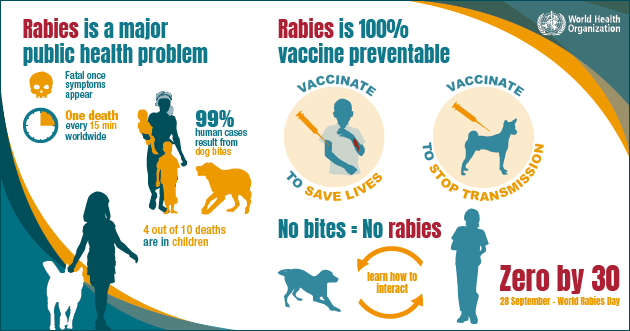In the United States, we don't talk about rabies very frequently. But September 28th was World Rabies Day. So, we want to revisit the topic of rabies, and some aspects of it that are lesser known.
Perhaps we don't focus on rabies because the rate of deaths in the United States due to rabies is extremely low - as in, almost none. There has been a huge drop in numbers of deaths over the last century that can be attributed in large part to two major public health measures. The first is the incredbily effective postexposure prophylaxis (PEP) that is given to anyone who has come into contact with an animal that is suspected of carrying rabies. The second is the push to vaccinate domestic animals. Before this was in effect, most of the rabies cases were seen in from domestic animals. Today, most of the rabies cases (over 90%) reported to the CDC are from incidents with wildlife.
Which animals carry rabies?
When I mentioned to ACSH president, Hank Campbell - who grew up hunting squirrels - that most people incorrectly think that squirrels carry rabies, he quickly asked in disbelief... "they don't?!?!?!"
At that point, I realized that I needed to talk about which animals carry rabies and which do not. Although any mammal can carry the rabies virus - some are far more common to have the virus than others. Although squirrels are capable of carrying rabies - they very infrequently do.
One of the reasons that smaller animals like squirrels, along with rabbits and small rodents are not frequently seen with rabies is because they are highly unlikely to survive an attack by a rabid animal.
The principal rabies hosts today are wild carnivores and bats. In the US, the most commonly reported rabid animal is the raccoon, followed by skunks and bats. Other common wild reservoirs of rabies are foxes and coyotes. Of course, domestic mammals can also get rabies. Dogs are the most frequently reported rabid domestic animals in the United States - with cattle and cats also being reported. Please see the map below for more information on the animals most likely to harbor rabies in your area.

Sometimes, you may not know if a bat bit you or not
When people find a bat in their home - it can lead to a tough decision regarding whether to proceed with rabies shots or not. You may think - as long as the bat did not bite them, they're fine, right? But, that is not always the case. People have reported not knowing that they have been bitten by a bat - especially when sleeping - mostly because bat teeth are incredibly sharp and small (see figure below of a bat bite.) This leads to a questionable situation as to how to proceed. However, with a lethality rate of almost 100% - most people will opt for the PEP instead of letting the situation play out as it may.

Puncture wound of a bite from a silver-haired bat - The Lancet, 2001, Vol 357, pp 1714
Is the lethality rate really 100%?
This is a difficult question to answer, but, some evidence points towards no. There are occasionally people in the United States who survive the infection without intervention, however, they are extremely rare. However, news of a group of people living in Peru that have antibodies to the virus, but, have never been sick may change the thinking on this otherwise unwavering killer. There are a few alternative explanations for this finding, but, one is that these people were infected at some point with rabies, but, didn't die.
Rabies virus causes 55,000 human deaths each year so a few people in Peru that are immune will not change the scale tremendously. But, it does give pause before using the 100% number to describe the viruses lethality.
There are two different ways to prevent rabies - one before a bite and one after
The PEP regimen is notorious for being harsh and painful. However, it is much improved.
Post-exposure treatment consists of first and foremost a dose of antibodies that go to work immediately to soak up and neutralize any virus that may be in the body. It also includes a series of vaccinations to elicit an immune response to the infection.
There is also a vaccine available to people who work in an area that is at high risk for exposure to the virus including working in a rabies lab, spelunker/caver, veterinarian, veterinary technician or assistant, veterinary student, animal control officer, shelter employee, or wildlife worker.
For the rest of us who don't work in these areas, we should make sure we follow the simple safety rules that focus on being safe with animals such as NOT approaching strange animals, handling downed bats or other sick, injured or dead animals, feeding wildlife.
The motto of the World Health Organization (WHO) is no bites = no rabies. Although we are lucky to have almost no deaths anymore in this country, there is one death every 15 minutes in the world - 40% of which are children. So, let's keep talking and learning about rabies and help the WHO achieve their goal of zero cases of rabies in the world by 2030.





